Text
Honorable mentions:
"autism"
"penis ehehahah"
"It's awesome :3"
If anyone was wondering the results are almost all queued up, I just have to go through the write in answers for "share anything else relevant" and make a list of my favorites
14 notes
·
View notes
Text
If anyone was wondering the results are almost all queued up, I just have to go through the write in answers for "share anything else relevant" and make a list of my favorites
14 notes
·
View notes
Text
Btw I plan to do the multigender survey yet again (idk if yall are getting bored of it but I'm having a great time), so if you have any feedback/suggestions based on the survey I am now posting results for feel free to send them to me :)
24 notes
·
View notes
Note
hiii!!! so uh, this is sorta about 'contradicting' (?) identities in general, but i only recently found out about, like, lesboys and gaygirls and all of that, but what is it exactly? like how does it work? or is that weird to ask? i'm trying figuring myself out but a lot of stuff i've seen doesn't exactly... explain it (or explain it well), and while i guess i do get why, it's just kinda hard to understand it myself for my own identity
also, probably a question you get a lot in a hating way, but isn't the definition of lesbian nonman loving nonman? so then how does lesboy work? like is it for people with more complicated gender identites, like fluctuating genders and bigender? just genuinly confused, my apologies...
sorry for not getting to this sooner- been busier lately and didn't have the time to collect everything I needed to respond!
About what it exactly means to be a lesboy or a gaygirl ('turigirl' is the more common term, 'turi' meaning turian, another word for gay attraction to men. so I'll be referring to it as that from now on), there isn't exactly....one right way to call yourself such. it really depends on the person, but I can give you a basic definition and a list of common reasons someone may call themselves such
im gonna put a read more because this ended up being super long so sorry
lesboy is a term for any lesbian who may have a connection to manhood and/or masculinity. turigirl is just the opposite of that, a gay person (mlm/nblm) who may have a connection to womanhood and/or femininity. common reasons I've seen are:
being multigender or genderfluid
being cusper/in between trans and cis gnc (in between trans man and cis gnc woman, in between trans woman and cis gnc man)
being a system who uses lesboy/turigirl as a collective identity or when identities blur together
a person who uses man/boy or woman/girl as a means of masculine or feminine gender expression but not actually identifying as such
being a trans man/ftm or a trans woman/mtf who still identifies as lesbian or gay for personal reasons
those are far from all the reasons, everyone has their own unique experiences, but the gist is these people may have some sort of connection to manhood/womanhood while still having a queer attraction. personally, I'm multigender, genderfluid, and transmasc. lesboy I find is a nice label to express being both my bigender self and being a lesbian, as it forces people to acknowledge both without separating the two. it's cute and makes me feel validated!
as for "nonman attracted to nonmen" definition of lesbian......it has its issues. it's received criticism all around from all sorts of lesbians in the community. this definition is very new - it emerged only in the recent years, and someone on twitter had date searched it and found it didn't even really exist before 2019. and having that as the one and only official definition that every lesbian has to abide by, when lesbian is a centuries old word with so much history behind it, is a bit ignorant. people who are multiple genders or ftm or bi being lesbian is not even remotely new, going back decades upon decades, and it never stopped existing too. It's a bit weird to have a whole new definition that doesn't include all sorts of lesbians that have been here for so long and just tell them they're not welcomed anymore, right?
that's not even close to the only issue there is with it. it's been disliked for centering lack of attraction to men, or defining lesbian in relation to men, rather than who we're actually attracted to. putting nonbinary people in a new binary of either being "men or nonmen," which not all feel comfortable putting themselves into. especially when considering a definition of gay being "nonwomen attracted to nonwomen," man-woman bigender people are simultaneously excluded from being both lesbian or gay. It inherently overlaps with mspec identity ("attraction to nonmen, which is more than one gender" and "any orientation that involves attraction to more than one gender" kinda obviously overlap), despite people insisting that a lesbian can never be mspec. people have found multiple loopholes in it, (which I can elaborate on if someone wants me to, for the sake of trying to make this as short as possible), and lastly, and term "nonman" (and nonwoman) were found to have existed before to describe the degendering of black people in society. this isn't the only source I've seen for this, but sadly I can't exactly find it (or find it without going back to that hellsite called twitter and I'm not doing that to myself)
oh and as the link points out, defining lesbian by these words also ends up excluding a lot of two-spirit people from ever identifying as lesbian, myself included. which is also really racist. I don't know how you're gonna end up excluding a whole cultural gender that's common for indigenous americans to describe themselves with and try to prove it somehow isn't racist, to be honest
and lastly, some surveys/polls have shown that the definition isn't the most widely accepted by lesbians as people make it out to be. there's this simple poll that someone posted asking how lesbians felt about the definition that received 1,529 responses, and 61.1% of voters said they disliked it. comments gave lots of reasons I've stated already. there was another survey put out that received 211 responses that for any lesbian who had a genderqueer or unique relationship with gender, and one of the questions asking opinions on the "nonmen loving nonmen" as a definition. the average among the group was slightly negative (average 2.838), and reported that the group who tended to feel the most positively about it didn't consider themselves to be trans, with the other positive leaning group considered themselves to be somewhat cis. the group that felt the most negatively sometimes considered themselves to be trans. and of the multigender participants, the average opinion was 2.255 (more negative than the overall average). When concluding, the original poster stated, "When divided by gender, the only groups to feel positive about this definition were "not trans" and "somewhat cis" participants. Multigender participants felt especially negative about this definition"
all of this shows that this definition isn't nearly the best for everyone who considers themselves a lesbian. I know it's been a way to include nonbinary people who are lesbian in it's definition, but I think it really misunderstands why nonbinary people are included in lesbianism in the first place, and just assumes that all nonbinary people aren't men and fails to recognize that multigender/genderfluid people are nonbinary too. and it's not like lesbian has to only have on definition- it can definitely have multiple and depend on each person's experience with it. if someone personally defines them being lesbian around being a nonman attracted to nonmen, and takes pride in not being attracted to men, that's totally fine. what becomes a problem is forcing all lesbians to define themselves like this and make it the standard, or else they're "not real lesbians." it is ahistorical and ignorant to require this or else you'll strip them of their lesbian status, and is really at the end of the day, lesbophobic. especially as a requirement that primarily exists in online spaces. im sure the lesbian who is not at all connected to these circles doesn't particularly care about strict requirements or whether someone is a "nonman" or not. in conclusion, it is not the best nor most accepted definition of lesbian, and deciding which lesbians are valid or not based solely on that definition is pretty exclusionary and ends up policing a lot of lesbians, myself included
66 notes
·
View notes
Text

made a heterosapphic pride flag since there doesnt really seem to be one of the way i use it
heterosapphic: someone who experiences their attraction to women as heterosexual and sapphic at the same time, or alternate between the two. you dont have to be a lesbian to use the term, but i am (:
32 notes
·
View notes
Text
#x axis = sets of pronouns (x10)#y axis = number of users#[i put `all pronouns` as 10 sets? that seemed somewhat reasonable but idk]
Cool bonus graph! Thank you
Multigender Survey Results Dec 2023: Language (part 1)
Number of pronouns
Participants were asked “How many sets of pronouns do you use?” (single selection) and participants whose pronouns differed depending on slightly were asked to answer what they used most often. The options provided were:
No pronouns: 2 (0.3%)
1 set of pronouns: 69 (9.3%) (nice)
2 sets of pronouns: 197 (26.5%)
3 sets of pronouns: 131 (17.6%)
4 sets of pronouns: 58 (7.8%)
5+ sets of pronouns: 98 (13.2%)
All pronouns: 72 (9.7%)
It changes regularly: 78 (10.5%)
Questioning: 38 (5.1%)

Number of pronouns vs number of genders
Participants’ answers to “How many sets of pronouns do you use?” and “How many genders do you identify as?” were compared and sorted into the following categories:
Number of pronouns is the same as the number of genders (for example, two genders and us two sets of pronouns): 109 (14.7%)
Number of pronouns is less than the number of genders (for example, all genders and one set of pronouns): 47 (6.3%)
Number of pronouns is more than the number of genders (for example, three genders and 5+ sets of pronouns): 56 (7.5%)
Number of pronouns and/or number of genders were non-numerical answers (for example, “I don’t know/I choose not to count them” for number of genders and all pronouns): 531 (71.5%)
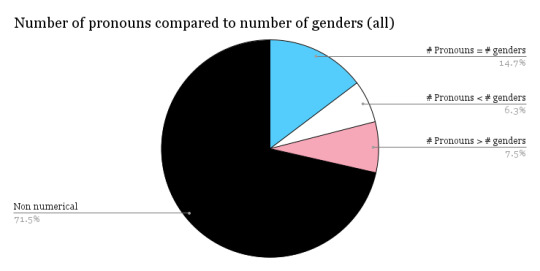
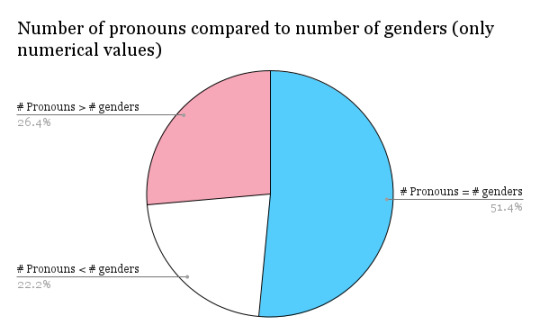
Multiple pronouns
Participants were asked “If you use multiple pronouns, do you prefer that people use all of your pronouns interchangeably?” (single selection). The options provided were:
Yes, and it is misgendering if they don’t: 81 (10.9% of participants overall, 11.8% of participants who use multiple pronouns)
Yes, but I don’t mind if they stick to one set: 366 (49.3% of participants overall, 53.2% of participants who use multiple pronouns)
No, I prefer that people stick to one set: 47 (6.3% of participants overall, 6.8% of participants who use multiple pronouns)
I don’t have a preference: 126 (17.0% of participants overall, 18.3% of participants who use multiple pronouns)
I don’t use multiple pronouns: 55 (7.4%)
There was also an “other” option in which participants could write in their answer. Written in answers were divided into the following categories:
It depends on context: 19 (2.6% of participants overall, 2.8% of participants who use multiple pronouns)
It depends on the pronouns (for example, using he/him and she/her interchangeably is preferred, using just he/him is okay, using just she/her is considered misgendering): 18 (2.4% of participants overall, 2.6% of participants who use multiple pronouns)
Preferences change frequently: 13 (1.7% of participants overall, 1.9% of participants who use multiple pronouns)
Yes, and I don’t like it if people stick to one set, but I don’t consider it misgendering: 11 (1.5% of participants overall, 1.6% of participants who use multiple pronouns)
Other: 7 (0.9% of participants overall, 1.0% of participants who use multiple pronouns)


Most common pronouns
Participants were asked “What pronouns do you use?” (multiple selection). For participants who only used a given set of pronouns sometimes, they were asked to select those pronouns for this question. The options provided were:
He/him: 565 (76.0%)
She/her: 380 (51.1%)
They/them: 422 (56.8%)
It/its: 275 (37.0%)
Xe/xem: 199 (16.0%)
Fae/faer: 66 (8.9%)
Ey/em: 66 (8.9%)
Ze/hir: 52 (7.0%)
Ze/zir: 59 (7.9%)
Ae/aer: 53 (7.1%)
E/em: 53 (7.1%)
Ce/cer: 22 (3.0%)
No pronouns: 69 (9.3%)
Any/all pronouns: 135 (18.2%)
Any/all neos: 124 (16.6%)

Additionally, there was an “other” option in which participants could write in pronouns. With the given and written in pronouns combined, a total of 171 unique subject pronouns were used.
Honorifics
Participants were asked “Which of these honorifics would you want to be referred to with?” (multiple selection). The options provided were:
Ind.: 40 (5.4%)
Lady: 14 (1.9%)
M.: 151 (20.3%)
Masteress: 33 (4.4%)
Miss/Ms./Mrs.: 165 (22.2%)
Mistrum: 47 (6.3%)
Mr.: 339 (45.6%)
Mx.: 108 (14.5%)
Sir: 328 (44.1%)
Sirlady: 62 (8.3%)
No honorific: 311 (41.9%)

119 notes
·
View notes
Text
Multigender Survey Results Dec 2023: Language (part 2)
Gendered terms
Participants were asked “What kind(s) of gendered terms do you prefer?” (multiple selection). The options provided were:
Masculine terms such as man, boy, etc: 599 (75.2%)
Feminine terms such as woman, girl, etc: 279 (37.6%)
General terms such as person, kid, etc: 489 (65.8%)
Nonbinary specific terms such as enban, enby, etc: 147 (19.8%)
Combined feminine and masculine terms such as manwoman, boygirl, etc: 323 (43.5%)
Nonhuman terms such as thing, creature, etc: 390 (52.5%)
I have no preference: 54 (7.3%)

Out of participants who answered “Combined masculine and feminine terms such as manwoman, boygirl, etc”:
142 answered both masculine and feminine terms (44.0%)
13 answered feminine terms but not masculine terms (4.0%)
120 answered masculine terms but not feminine terms (37.2%)
48 did not answer masculine or feminine terms (14.9%)
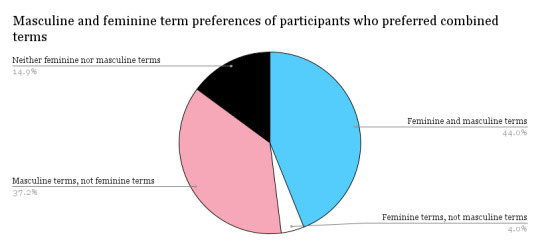
Gendered terms, pronouns, and labels
Masculinity
Participants were compared based on whether they answered “Masculine terms such as man, boy, etc” to the question “What kind(s) of gendered terms do you prefer,” “He/him” to the question “What pronouns do you use?” and “Man/boy/male” to the question “What are the genders you identify with?” and divided into the following categories
Identify as a man/boy/male, prefer masculine terms, and use he/him pronouns: 366 (49.3%)
Identify as a man/boy/male, don’t prefer masculine terms, and use he/him pronouns: 40 (5.4%)
Identify as a man/boy/male, prefer masculine terms, and don’t use he/him pronouns: 46 (6.2%)
Identify as a man/boy/male, don’t prefer masculine terms, and don’t use he/him pronouns: 18 (2.4%)
Don’t identify as a man/boy/male, prefer masculine terms, and use he/him pronouns: 106 (14.3%)
Don’t identify as a man/boy/male, don’t prefer masculine terms, and use he/him pronouns: 53 (7.1%)
Don’t identify as a man/boy/male, prefer masculine terms, and don’t use he/him pronouns: 41 (5.5%)
Don’t identify as a man/boy/male, don’t prefer masculine terms, and don’t use he/him pronouns: 73 (9.8%)

Femininity
Participants were compared based on whether they answered “Feminine terms such as woman, girl, etc” to the question “What kind(s) of gendered terms do you prefer,” “She/her” to the question “What pronouns do you use?” and “Woman/girl/female” to the question “What are the genders you identify with?” and divided into the following categories
Identify as a woman/girl/female, prefer feminine terms, and use she/her pronouns: 187 (25.2%)
Identify as a woman/girl/female, don’t prefer feminine terms, and use she/her pronouns: 87 (11.7%)
Identify as a woman/girl/female, prefer feminine terms, and don’t use she/her pronouns: 37 (5.0%)
Identify as a woman/girl/female, don’t prefer feminine terms, and don’t use she/her pronouns: 88 (11.8%)
Don’t identify as a woman/girl/female, prefer feminine terms, and use she/her pronouns: 35 (4.7%)
Don’t identify as a woman/girl/female, don’t prefer feminine terms, and use she/her pronouns: 71 (9.6%)
Don’t identify as a woman/girl/female, prefer feminine terms, and don’t use she/her pronouns: 20 (2.7%)
Don’t identify as a woman/girl/female, don’t prefer feminine terms, and don’t use she/her pronouns: 218 (29.3%)

Femininity+Masculinity
Participants were compared based on whether they answered “Combined feminine and masculine terms such as manwoman, boygirl, etc” to the question “What kind(s) of gendered terms do you prefer,” “He/him” and “She/her” to the question “What pronouns do you use?” and “Manwoman/boygirl/male+female” to the question “What are the genders you identify with?” and divided into the following categories
Identify as a manwoman/boygirl/male+female, prefer combined terms, and use he/she pronouns: 156 (21.0%)
Identify as a manwoman/boygirl/male+female, don’t prefer combined terms, and use he/she pronouns: 66 (8.9%)
Identify as a manwoman/boygirl/male+female, prefer combined terms, and don’t use he/she pronouns: 112 (15.1%)
Identify as a manwoman/boygirl/male+female, don’t prefer combined terms, and don’t use he/she pronouns: 64 (8.6%)
Don’t identify as a manwoman/boygirl/male+female, prefer combined terms, and use he/she pronouns: 22 (3.0%)
Don’t identify as a manwoman/boygirl/male+female, don’t prefer combined terms, and use he/she pronouns: 83 (11.2%)
Don’t identify as a manwoman/boygirl/male+female, prefer combined terms, and don’t use he/she pronouns: 33 (4.4%)
Don’t identify as a manwoman/boygirl/male+female, don’t prefer combined terms, and don’t use he/she pronouns: 207 (27.9%)

Nonhumanity
Participants were compared based on whether they answered “Nonhuman terms such as thing, creature, etc” to the question “What kind(s) of gendered terms do you prefer,” and “It/its” to the question “What pronouns do you use?” and divided into the following categories:
Prefer nonhuman terms, use it/its pronouns: 218 (29.3%)
Don’t prefer nonhuman terms, use it/its pronouns: 172 (23.1%)
Prefer nonhuman terms, don’t use it/its pronouns: 57 (7.7%)
Don’t prefer nonhuman terms, don’t use it/its pronouns: 296 (39.8%)

Abinary
The answers to “What kind(s) of gendered terms do you prefer” from participants with one or more abinary gender were compared to answers from participants overall.
Participants with one or more abinary gender were significantly less likely to prefer
Nonhuman terms such as thing, creature, etc: 110 (25.6%)
26.8 percentage points lower than participants overall (p < 0.001)
Feminine terms such as woman, girl, etc: 134 (31.2%)
6.3 percentage points lower than participants overall (p < 0.01)
and significantly more likely to prefer
General terms such as person, kid, etc: 306 (71.3%)
5.5 percentage points higher than participants overall (p < 0.05)
Nonbinary specific terms such as enban, enby, etc: 266 (62.0%)
42.2 percentage points higher than participants overall (p < 0.001)
#survey results december 2023#multigender#it was actually super interesting to see the breakdown of whether people's identities + pronouns + term preferences matched up#fascinating shit
26 notes
·
View notes
Text
this lesbian visibility week, i am asking monogender lesbians to be normal about multigender lesbians
60 notes
·
View notes
Text
Multigender Survey Results Dec 2023: Language (part 1)
Number of pronouns
Participants were asked “How many sets of pronouns do you use?” (single selection) and participants whose pronouns differed depending on slightly were asked to answer what they used most often. The options provided were:
No pronouns: 2 (0.3%)
1 set of pronouns: 69 (9.3%) (nice)
2 sets of pronouns: 197 (26.5%)
3 sets of pronouns: 131 (17.6%)
4 sets of pronouns: 58 (7.8%)
5+ sets of pronouns: 98 (13.2%)
All pronouns: 72 (9.7%)
It changes regularly: 78 (10.5%)
Questioning: 38 (5.1%)

Number of pronouns vs number of genders
Participants’ answers to “How many sets of pronouns do you use?” and “How many genders do you identify as?” were compared and sorted into the following categories:
Number of pronouns is the same as the number of genders (for example, two genders and us two sets of pronouns): 109 (14.7%)
Number of pronouns is less than the number of genders (for example, all genders and one set of pronouns): 47 (6.3%)
Number of pronouns is more than the number of genders (for example, three genders and 5+ sets of pronouns): 56 (7.5%)
Number of pronouns and/or number of genders were non-numerical answers (for example, “I don’t know/I choose not to count them” for number of genders and all pronouns): 531 (71.5%)


Multiple pronouns
Participants were asked “If you use multiple pronouns, do you prefer that people use all of your pronouns interchangeably?” (single selection). The options provided were:
Yes, and it is misgendering if they don’t: 81 (10.9% of participants overall, 11.8% of participants who use multiple pronouns)
Yes, but I don’t mind if they stick to one set: 366 (49.3% of participants overall, 53.2% of participants who use multiple pronouns)
No, I prefer that people stick to one set: 47 (6.3% of participants overall, 6.8% of participants who use multiple pronouns)
I don’t have a preference: 126 (17.0% of participants overall, 18.3% of participants who use multiple pronouns)
I don’t use multiple pronouns: 55 (7.4%)
There was also an “other” option in which participants could write in their answer. Written in answers were divided into the following categories:
It depends on context: 19 (2.6% of participants overall, 2.8% of participants who use multiple pronouns)
It depends on the pronouns (for example, using he/him and she/her interchangeably is preferred, using just he/him is okay, using just she/her is considered misgendering): 18 (2.4% of participants overall, 2.6% of participants who use multiple pronouns)
Preferences change frequently: 13 (1.7% of participants overall, 1.9% of participants who use multiple pronouns)
Yes, and I don’t like it if people stick to one set, but I don’t consider it misgendering: 11 (1.5% of participants overall, 1.6% of participants who use multiple pronouns)
Other: 7 (0.9% of participants overall, 1.0% of participants who use multiple pronouns)


Most common pronouns
Participants were asked “What pronouns do you use?” (multiple selection). For participants who only used a given set of pronouns sometimes, they were asked to select those pronouns for this question. The options provided were:
He/him: 565 (76.0%)
She/her: 380 (51.1%)
They/them: 422 (56.8%)
It/its: 275 (37.0%)
Xe/xem: 199 (16.0%)
Fae/faer: 66 (8.9%)
Ey/em: 66 (8.9%)
Ze/hir: 52 (7.0%)
Ze/zir: 59 (7.9%)
Ae/aer: 53 (7.1%)
E/em: 53 (7.1%)
Ce/cer: 22 (3.0%)
No pronouns: 69 (9.3%)
Any/all pronouns: 135 (18.2%)
Any/all neos: 124 (16.6%)

Additionally, there was an “other” option in which participants could write in pronouns. With the given and written in pronouns combined, a total of 171 unique subject pronouns were used.
Honorifics
Participants were asked “Which of these honorifics would you want to be referred to with?” (multiple selection). The options provided were:
Ind.: 40 (5.4%)
Lady: 14 (1.9%)
M.: 151 (20.3%)
Masteress: 33 (4.4%)
Miss/Ms./Mrs.: 165 (22.2%)
Mistrum: 47 (6.3%)
Mr.: 339 (45.6%)
Mx.: 108 (14.5%)
Sir: 328 (44.1%)
Sirlady: 62 (8.3%)
No honorific: 311 (41.9%)

119 notes
·
View notes
Text
41 notes
·
View notes
Text
Multigender Survey Results Dec 2023: Genders (part 2)
Gender number and labels
Participants were asked “What multigender-related labels do you use in addition to multigender?” (multiple selection). The options provided were: androgyne, bigender, genderfluid, omnigender, pangender, polygender, trigender, and none, as well as a write in option.
Participants were asked “How many genders do you identify as?” (single selection). The options provided were: 2, 3, 4, 5, more than five but not all, all, it changes, and I don’t know/I choose not to count them, as well as a write in option.
Multigender-related labels:
Androgyne: 139 (18.7%)
Most common number of genders: don’t know/choose not to count (58, 41.7%)
Bigender: 342 (46.0%)
Most common number of genders: two (125, 36.5%)
Genderfluid: 372 (50.1%)
Most common number of genders: don’t know/choose not to count (155, 41.7%)
Omnigender: 30 (4.0%)
Most common number of genders: it changes (12, 40.0%)
Pangender: 64 (8.6%)
Most common number of genders: don’t know/choose not to count (22, 34.4%)
Polygender: 63 (8.5%)
Most common number of genders: don’t know/choose not to count (26, 41.3%)
Trigender: 28 (3.8%)
Most common number of genders: it changes (9, 32.1%)
None: 122 (16.4%)
Most common number of genders: don’t know/choose not to count (74, 60.7%)
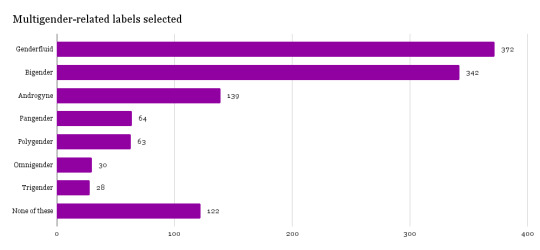
Number of genders:
Two: 137 (18.4%)
Most common multigender-related label: Bigender (125, 91.2%)
Three: 28 (3.8%)
Most common multigender-related label: Genderfluid (16, 57.1%)
Four: 10 (1.3%)
Most common multigender-related label: Genderfluid (5, 50.0%)
Five: 3 (0.4%)
Most common multigender-related label: Genderfluid (3, 100%)
More than five, but not all: 30 (4.0%)
Most common multigender-related label: Genderfluid (14, 46.7%)
All: 24 (3.2%)
Most common multigender-related label: Pangender (16, 66.7%)
It changes: 165 (22.2%)
Most common multigender-related label: Genderfluid (128, 77.6%)
I don’t know/I choose not to count them: 311 (41.9%)
Most common multigender-related label: Genderfluid (155, 49.8%)
Other: 35 (4.7%)
Most common multigender related label: Bigender (14, 40.0%)

Fluidity
Participants were asked “Is your gender fluid?” (single selection). The options provided were:
Yes, and I only ever experience one at a time: 35 (4.7%)
Yes, and I experience more than one at a time, either always or sometimes: 455 (61.2%)
Questioning: 102 (13.7%)
No: 151 (20.3%)
490 (65.9%) had some sort of fluid gender, whether they experienced one or multiple at a time.
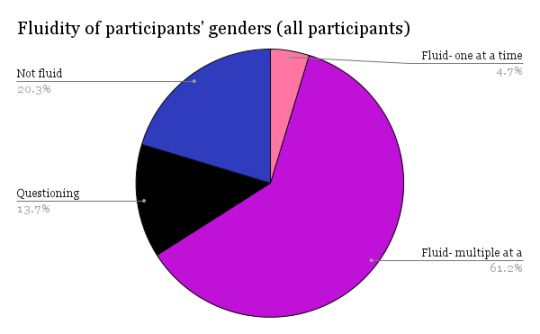
Of participants who used the genderfluid label…
28 answered “Yes, and I only ever experience one at a time” (7.5% of participants who used the genderfluid label)
323 answered “Yes, and I experience more than one at a time, either always or sometimes” (86.8% of participants who used the genderfluid label)
19 answered “Questioning” (5.1% of participants who used the genderfluid label)
2 answered “No” (0.5% of participants who used the genderfluid label
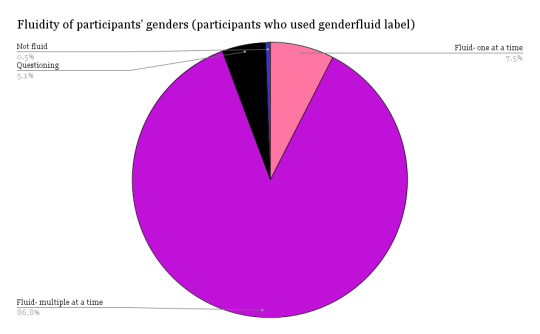
Of participants who used the bigender label…
8 answered “Yes, and I only ever experience one at a time” (2.3% of participants who used the bigender label)
201 answered “Yes, and I experience more than one at a time, either always or sometimes” (58.8% of participants who used the bigender label)
44 answered “Questioning” (12.9% of participants who used the bigender label)
89 answered “No” (26.0% of participants who used the bigender label)

Participants who used the bigender label were significantly less likely than participants overall to answer “Yes, and I only ever experience one at a time” (p < 0.05) and significantly more likely than participants overall to answer “No” (p < 0.01).
Nonbinary Identity
Participants were asked “Do you identify as nonbinary?” (single selection). The options provided were:
Yes, nonbinary is one of the genders that I identify with: 82 (11.0%)
77 participants who selected this option also used the nonbinary label (93.9% of participants who selected this option)
Yes, nonbinary describes my gender identity overall: 130 (17.5%)
121 participants who selected this option also used the nonbinary label (93.1% of participants who selected this option)
Yes, nonbinary is both my overall gender identity and a specific gender I identify with: 115 (15.5%)
113 participants who selected this option also used the nonbinary label (98.3% of participants who selected this option)
Somewhat, the nonbinary label is technically accurate but it's not what I prefer: 213 (28.7%)
88 participants who selected this option also used the nonbinary label (41.3% of participants who selected this option)
Somewhat, it changes or depends on context: 70 (9.4%)
51 participants who selected this option also used the nonbinary label (72.9% of participants who selected this option)
No, but I don't mind being referred to as such: 44 (5.9%)
6 participants who selected this option also used the nonbinary label (13.6% of participants who selected this option)
No, and being referred to as such is misgendering: 78 (10.5%)
2 participants who selected this option also used the nonbinary label (2.6% of participants who selected this option)
Other (write-in): 11 (1.5%)
6 participants who selected this option also used the nonbinary label (54.5% of participants who selected this option)

Of participants who used the nonbinary label…
77 answered “Yes, nonbinary is one of the genders that I identify with” (16.6% of participants who used the nonbinary label)
121 answered “Yes, nonbinary describes my gender identity overall” (26.1% of participants who used the nonbinary label)
113 answered “Yes, nonbinary is both my overall gender identity and a specific gender I identify with” (24.4% of participants who used the nonbinary label)
88 answered “Somewhat, the nonbinary label is technically accurate but it's not what I prefer” (19.0% of participants who used the nonbinary label)
51 answered “Somewhat, it changes or depends on context” (11.0% of participants who used the nonbinary label)
6 answered “No, but I don't mind being referred to as such” (1.3% of participants who used the nonbinary label)
2 answered “No, and being referred to as such is misgendering” (0.4% of participants who used the nonbinary label)
6 answered “other” (1.3% of participants who used the nonbinary label)

#survey results december 2023#survey stuff#multigender#whooooo!#shoutout to the bigenders for our statistical significance <2
46 notes
·
View notes
Text
I made the mistake of posting the first of the survey results right before Passover which was kind of bad timing lmao, we should be back to our regularly scheduled multigender data soon
#it's still passover but no more cleaning + no more seders to prepare for#so. more time for multigender things!
16 notes
·
View notes
Note
what in god's fuck is a lesboy or a cistrans person i have literally never heard those words in my entire life
So glad you asked politely and totally in good faith instead of being weird about it!
Lesboys in the most simple terms are lesbian boys. They may or may not identify as actual boys/men. Some lesboys are butches that like to be referred to with masculine terms, some are multigender or genderfluid, and some have an even more complex relationship with gender. The term is meant for people with really complicated relationships with gender identity that influences how they experience lesbianism.
Cistrans is a term usually used by intersex folks or multigender people. Multigender people may identify as a gender that is their AGAB and other genders, thus making them cis and trans at the same time. As for intersex people, we tend to have really complex relationships with our transition because our bodies don’t neatly fit into binary standards.
Hope this helps!
95 notes
·
View notes
Text
never let being a girl stop you from being a boy
34K notes
·
View notes
Note
Hello S. Did you mean to reblog bark mitzvah to your multigender blog /silly
No I did not! Wrong blog incident 69 dead 420 injured
17 notes
·
View notes
Text
Multigender Survey Results Dec 2023: Genders (part 1)
Multigender versus questioning
The first question asked participants to indicate whether they were multigender or were questioning (single selection). 594 participants (80.1%) identified as multigender, while 148 (19.%) were questioning whether they identified as multigender.

Categories
Participants were asked to select which of the following best described the extent to which they identified as a woman, a girl, and/or female (single selection). The options provided were:
I am fully a woman, a girl, and/or female: 196 (26.4%)
I am partially a woman, a girl, and/or female: 417 (56.1%)
I am not a woman, a girl, or female in any capacity: 130 (17.5%)
613 (82.5%) identified as a woman, a girl, and/or female to some extent, whether fully or partially.
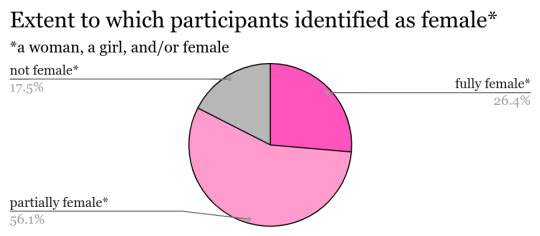
Participants were also asked to select which of the following best described the extent to which they identified as a man, a boy, and/or male (single selection). The options provided were:
I am fully a man, a boy, and/or male: 297 (40.0%)
I am partially a man, a boy, and/or male: 393 (52.9%)
I am not a man, a boy, or male in any capacity: 53 (7.1%)
690 (92.9%) identified as a man, a boy, and or/male to some extent, whether fully or partially.
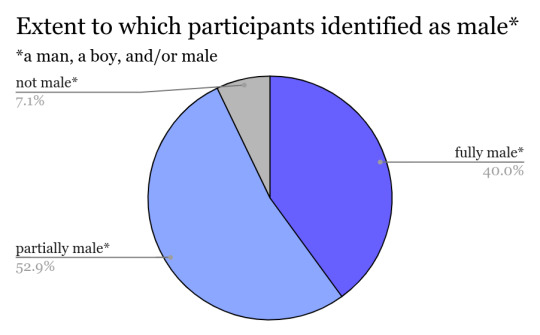
The combination of answers to those two questions were used to sort participants into the following nine categories.
Fully a man, a boy, and/or male + fully a woman, a girl, and/or female: 151 (20.3%)
Partially a man, a boy, and/or male + fully a woman, a girl, and/or female: 40 (5.4%)
Not at all a man, a boy, or male + fully a woman, a girl, and/or female: 5 (0.7%)
Fully a man, a boy, and/or male + partially a woman, a girl, and/or female: 103 (13.9%)
Partially a man, a boy, and/or male + partially a woman, a girl, and/or female: 288 (38.8%)
Not at all a man, a boy, or male + partially a woman, a girl, and/or female: 26 (3.5%)
Fully a man, a boy, and/or male + not at all a woman, a girl, or female: 43 (5.8%)
Partially a man, a boy, and/or male + not at all a woman, a girl, or female: 65 (8.7%)
Not a man, a boy, and/or male + not at all a woman, a girl, or female: 22 (3.0%)

Number of binary genders (man/boy/male and woman/girl/female) participants fully identified as:
Fully identified as two binary genders: 151 (20.3%)
Fully identified as one binary gender: 191 (25.7%)
Did not fully identify as any binary gender: 401 (54.0%)

Number of binary genders (man/boy/male and woman/girl/female) participants identified as to some extent, whether fully or partially:
Identified as two binary genders to some extent: 582 (78.3%)
Identified as one binary gender to some extent: 139 (18.7%)
Did not identify as any binary gender to any extent: 22 (3.0%)

Labels
Participants were asked “What are the genders you identify with? Select all that apply, whether always or sometimes” (multiple selection). The options provided were:
Agender: 268 (36.1%)
Butch: 223 (30.0%)
Demigirl: 142 (19.1%)
Demiboy: 174 (23.4%)
Femme: 202 (27.2%)
Genderqueer: 500 (67.3%)
Man/boy/male: 470 (63.3%)
Manwoman/boygirl/male+female: 398 (53.6%)
Masc: 351 (47.2%)
Maverique: 72 (9.7%)
Neutrois: 69 (9.3%) (nice_
Nonbinary: 464 (62.3%)
Woman/girl/female: 399 (53.7%)
Xenogender: 248 (33.4%)
Questioning: 110 (14.8%)
Unlabeled: 129 (17.4%)
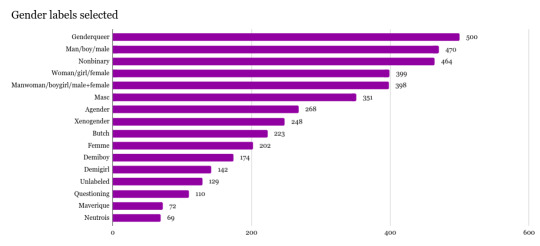
Categories vs Labels
In the previous survey, categories were formed based on answers to the question “What are the genders you identify with?” This turns out to have been an inaccurate way to categorize participants, as the categories participants self-identified with often didn’t match the way they would have been categorized based on the genders they identified with.
Of 196 participants who identified as fully a woman, a girl, and/or female, 166 selected “woman/girl/female” as one of the genders they identified with (84.7%). Of 297 participants who identified as fully a man, a boy, and/or male, 259 selected “man/boy/male” as one of the genders they identified with (87.2%).
Additionally, the previous survey did not include “manwoman/boygirl/male+female” as a gender option, under the assumption that people who identified that way would select both “man/boy/male” and “woman/girl/female.” However, of the 398 participants who selected “manwoman/boygirl/male+female,” 210 selected both “man/boy/male” and “woman/girl/female” (52.8%). 142 participants who selected “manwoman/boygirl/male+female” did not select “woman/girl/female” (35.7%), and 117 participants who selected “manwoman/boygirl/male+female” did not select “man/boy/male” (29.4%).
Abinary Genders
Participants were asked “do you experience abinary gender(s)?” (single selection), with abinary defined as “genders that are completely unrelated to the male/female binary.” The options provided were:
No, I don’t experience any abinary genders: 143 (19.2%)
Yes, I experience one abinary gender: 144 (19.4%)
Yes, I experience multiple abinary genders: 285 (38.4%)
Questioning: 171 (23.0%)
429 participants (75.7%) experienced one or more abinary gender(s).

Of the 151 participants who identified as fully a man, a boy, and/or male as well as fully a woman, a girl, and/or female, 19 (12.6%) experienced one abinary gender and 62 (41.1%) experienced multiple abinary genders. 81 (53.6%) experienced one or more abinary gender(s) and 49 (32.5%) did not experience any abinary genders. That is to say, for a majority of participants who identified as fully a man/a boy/male and fully a woman/a girl/female, they identified as other gender(s) in addition to those two.
96 notes
·
View notes